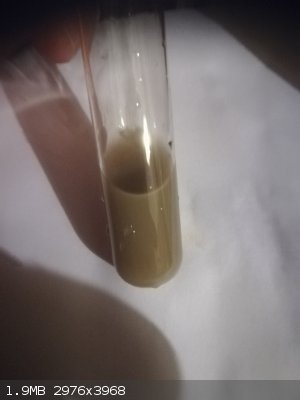Bedlasky
International Hazard
    
Posts: 1219
Registered: 15-4-2019
Location: Period 5, group 6
Member Is Offline
Mood: Volatile
|
|
Sulfides of Mo, W and V
Hi.
I precipitated some metal sulfides with sodium polysulfide today. And I have few questions about it.
I added polysulfide in to the test tube with acidifed vanadate solution and brown precipitate was form. I actually don't know what sulfide it is.
V2S3, VS2, VOS or another sulfide? I suppose it is V2S3, because dithionite have similar reduction properties as polysulfides and reduce vanadate in
to vanadium(III). But I am not sure if it is V2S3.

I added polysulfide in to acidifed molybdate solution and brown to grey precipitate was form. This is MoS3 (with some sulfur and molybdenum blue which
caused grey colour of precipitate if molybdate is more concentrated). I read in book and on the internet that MoS3 is soluble in sulfide solution
gives dark red solution of thiomolybdates. But it doesn't worked. Why? Too much acid in solution?
I added polysulfide and sulfuric acid in to tungstate solution. White precipitate was form. This white precipitate definitely wasn't WO3. But in
literature is that WS3 is brown. So what is it? After additon NaOH in to solution precipitate turned blue due to formation of tungsten blue. But why
after additon NaOH? Reaction with polysulfide in alkaline solution normally doesn't occur.
If someone know answer for any of my questions I will be grateful  . .
Edit: Sorry, I don't know why two last pictures don't show up
Attachment: phpmG4nJE (1.5MB)
This file has been downloaded 338 times
Attachment: phpWpIS5d (1.8MB)
This file has been downloaded 339 times
[Edited on 26-8-2019 by Bedlasky]
|
|
|
wg48temp9
National Hazard
   
Posts: 761
Registered: 30-12-2018
Location: not so United Kingdom
Member Is Offline
|
|
I don'i know the answers to your specific questions but I can give you some info on Mo oxides.
First if you made your poly sulfide by dissolving sulfur in alkali solution you have a complex mixture of various compounds from memory sulfite.
thiosufate and various sulfides.
Mo form a large variety of oxides and oxysulfides depending on the ph and the reactant concentrations.
Note that acidifying polysulfides can produce a white precipitate of sulfur. Mo blue can be oxidized to a colorless/yellow compound. Perhaps you
could use that fact to test your blue is Mo blue
Here a paper on Thiomolybdates:
Attachment: Thiomolybdates-laurie2000.pdf (407kB)
This file has been downloaded 252 times
Here is an interesting snippet from the above:
"Formation of TTM from MoO4(2-) clearly proceeds via
successive replacement of oxygen, as evidenced from the
colour sequence change in solution:
MoO4S(2-) (colourless)
->MoO3S(2-) (yellow)
->MoO2S2(2-) (orange)
->MoOS3(2-) (orange-red)
->MoS4 (2-) (red)."
I am wg48 but not on my usual pc hence the temp handle.
Thank goodness for Fleming and the fungi.
Old codger' lives matters, wear a mask and help save them.
Be aware of demagoguery, keep your frontal lobes fully engaged.
I don't know who invented mRNA vaccines but they should get a fancy medal and I hope they made a shed load of money from it.
|
|
|
j_sum1
Administrator
       
Posts: 6229
Registered: 4-10-2014
Location: Unmoved
Member Is Offline
Mood: Organised
|
|
Worthwhile noting here that S, Mo and W are all hexavalent and have some similarities in behaviour (along with Cr). Notably the ability to form a
range of oxyanions and polyions. Molybdates are famous for their diversity and complexity. I fear you probably have an intractable mixture of
complex species beyond your ability to analyse.
|
|
|
Bedlasky
International Hazard
    
Posts: 1219
Registered: 15-4-2019
Location: Period 5, group 6
Member Is Offline
Mood: Volatile
|
|
Thanks for answers.
Polysulfide probably mask formation of these thiomolybdates because it is yellow to orange too.
I test if molybdenum/tungsten blue was formed. In to the solution with MoS3 I added some NaOH. MoS3 hydrolysed and I had yellow-bluish
precipitate/solution. I added some sulfite and heat it on water bath. Sulfur dissolved and I had clear blue solution. But amount of molybdenum blue
wasn't big.
But with white tungsten precipitate it was different. After additon of NaOH I had blue precipitate/solution. After heating with sulfite I had clear
blue solution again.
I tested reduction of molybdate by polysulfide in alkaline solution but nothing happened (I suppose, that tungstate doesn't react with polysulfide too
because it's less reactive than molybdate). So I really don't understand why wasn't formed brown WS3 instead of some white precipitate and colour
change white tungsten precipitate after addition of NaOH.
Maybe I will try dissolve some H2S in neutral or ammoniacal molybdate/tungstate solution. But it's smelly and toxic work  . .
[Edited on 26-8-2019 by Bedlasky]
|
|
|
Bedlasky
International Hazard
    
Posts: 1219
Registered: 15-4-2019
Location: Period 5, group 6
Member Is Offline
Mood: Volatile
|
|
I've did little analysis of vanadium sulfide today. It hydrolize in strongly alkaline media in to yellowis greeen precipitate. It looks like mix of
sulfur and V(OH)3, so it's probably V2S3.
|
|
|
Bezaleel
Hazard to Others
  
Posts: 444
Registered: 28-2-2009
Member Is Offline
Mood: transitional
|
|
A few years ago I tried to make some tetrathiomolybdate, [MoS4]2-. I was only somewhat successful. The anion is quite unstable. I made it by bubbling
H2S through a molybdenum compound in a testtube with water, and indeed some reddish compound formed. I need to look up the details whether it was in
an acid or alkaline environment and which Mo compound was used as the starting material.
|
|
|